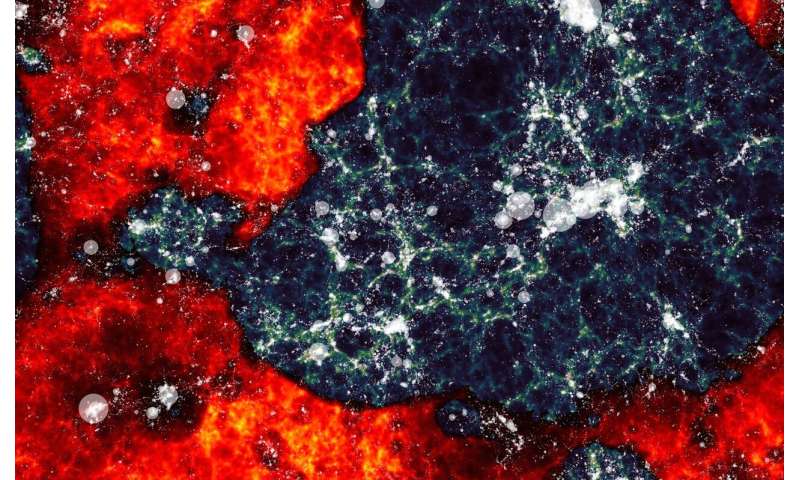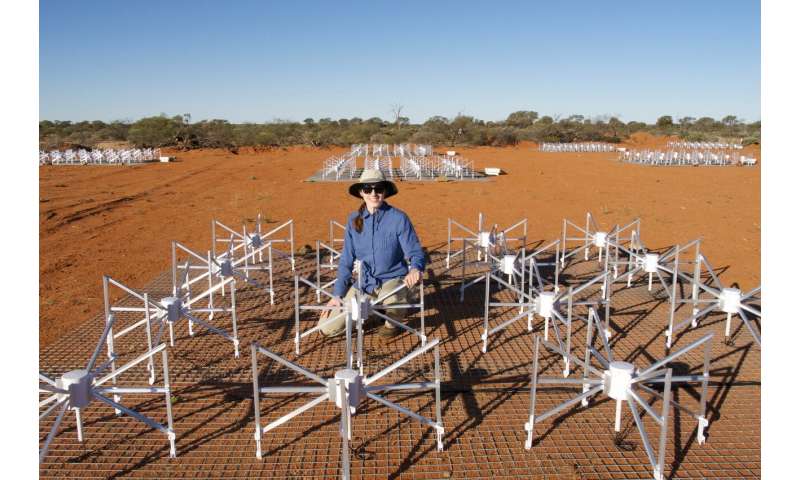
Astronomers are closing in on a signal that has been travelling across the Universe for 12 billion years, bringing them nearer to understanding the life and death of the very earliest stars.
In a paper on the preprint site arXiv and soon to be published in the Astrophysical Journal, a team led by Dr. Nichole Barry from Australia's University of Melbourne and the ARC Centre of Excellence for All Sky Astrophysics in 3 Dimensions (ASTRO 3-D) reports a 10-fold improvement on data gathered by the Murchison Widefield Array (MWA) - a collection of 4096 dipole antennas set in the remote hinterland of Western Australia.
The MWA, which started operating in 2013, was built specifically to detect electromagnetic radiation emitted by neutral hydrogen—a gas that comprised most of the infant Universe in the period when the soup of disconnected protons and neutrons spawned by the Big Bang started to cool down.
Eventually these hydrogen atoms began to clump together to form stars—the very first ones to exist—initiating a major phase in the evolution of the Universe, known as the Epoch of Reionisation, or EoR.
"Defining the evolution of the EoR is extremely important for our understanding of astrophysics and cosmology," explains Dr. Barry.
"So far, though, no one has been able to observe it. These results take us a lot closer to that goal."
The neutral hydrogen that dominated space and time before and in the early period of the EoR radiated at a wavelength of approximately 21 centimetres. Stretched now to somewhere above two metres because of the expansion of the Universe, the signal persists—and detecting it remains the theoretical best way to probe conditions in the early days of the Cosmos.
However, doing so is fiendishly difficult.
"The signal that we're looking for is more than 12 billion years old," explains ASTRO 3-D member and co-author Associate Professor Cathryn Trott, from the International Centre for Radio Astronomy Research at Curtin University in Western Australia.
"It is exceptionally weak and there are a lot of other galaxies in between it and us. They get in the way and make it very difficult to extract the information we're after."
In other words, the signals recorded by the MWA—and other EoR-hunting devices such as the Hydrogen Epoch of Reionisation Array in South Africa and the Low Frequency Array in The Netherlands—are extremely messy.
Using 21 hours of raw data Dr. Barry, co-lead author Mike Wilensky, from the University of Washington in the US, and colleagues explored new techniques to refine analysis and exclude consistent sources of signal contamination, including ultra-faint interference generated by radio broadcasts on Earth.

The result was a level of precision that significantly reduced the range in which the EoR may have begun, pulling in constraints by almost an order of magnitude.
"We can't really say that this paper gets us closer to precisely dating the start or finish of the EoR, but it does rule out some of the more extreme models," says Professor Trott.
"That it happened very rapidly is now ruled out. That the conditions were very cold is now also ruled out."
Dr. Barry said the results represented not only a step forward in the global quest to explore the infant Universe, but also established a framework for further research.
"We have about 3000 hours of data from MWA," she explains, "and for our purposes some of it is more useful than others. This approach will let us identify which bits are most promising, and analyse it better than we ever could before."
Explore further
Provided by ARC Centre of Excellence for All Sky Astrophysics in 3D
Citation: And then there was light: looking for the first stars in the Universe (2019, September 9) retrieved 9 September 2019 from https://phys.org/news/2019-09-stars-universe.html
This document is subject to copyright. Apart from any fair dealing for the purpose of private study or research, no part may be reproduced without the written permission. The content is provided for information purposes only.
Bagikan Berita Ini














0 Response to "And then there was light: looking for the first stars in the Universe - Phys.org"
Post a Comment